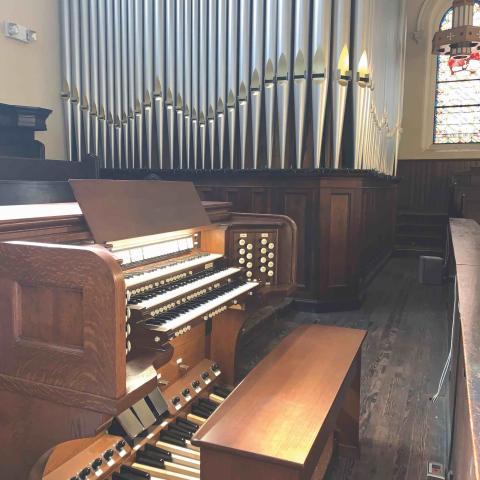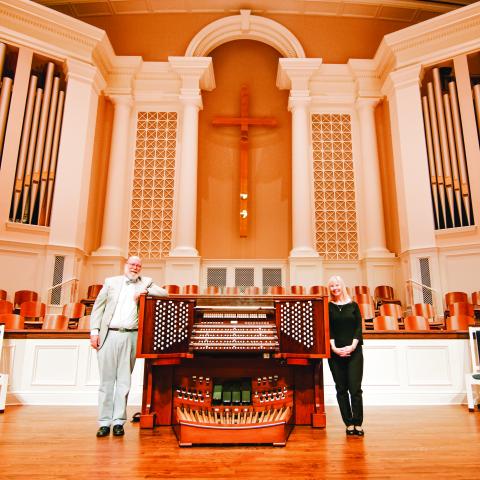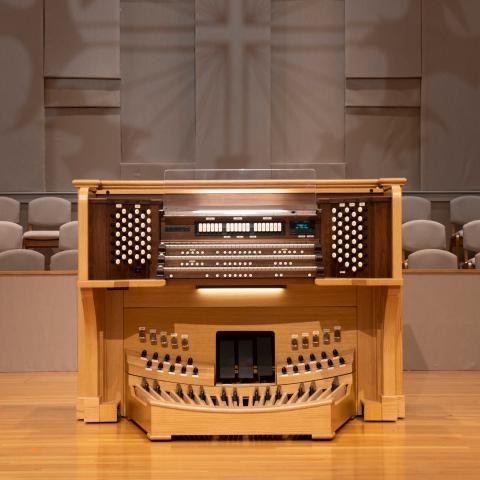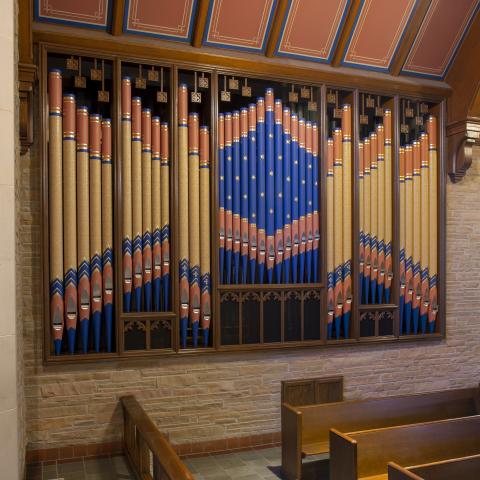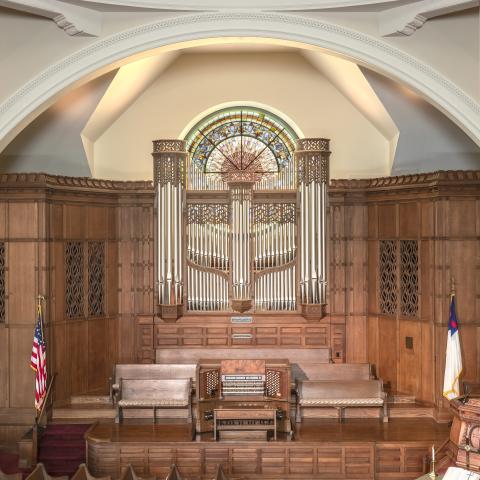Foley-Baker, Inc., Tolland, Connecticut
Saving Organs—“101”

Foley-Baker, Inc., Tolland, Connecticut
Saving Organs—“101”
Times have changed, and over recent decades there’s been added concentration on the complete reconditioning of pipe organs. As many will note, rather than only new instruments, front cover articles now occasionally feature older organs that have been completely reconditioned. Granted, they’re usually high profile, large projects; it’s always great to know these important organs have been saved.
But for all the large ones, there are many smaller pipe organs with good roots that remain important to the communities they serve. Some are musically special and, given that they make up the musical fabric of most American churches, it seemed right to feature some smaller, older organs that were selected for major reconditioning. The projects here were all completed between ten and twenty years ago. Also, the organists then are the organists now. When recently asked what they would do differently, their answers were unanimous—nothing! Looking back, each felt their decision to totally renovate was right, financially and musically.
Once their chassis are at our shops and the equipment laid out on the benches, our technicians get a peek into the past as some of the earlier electric- and tubular-pneumatic actions can test the best. The learning process uncovers both revelations and disasters in chassis design. Our techs are always eager to figure out how something was supposed to work. Sometimes figuring it out helps to understand why a particular firm’s output wasn’t very big. Regardless, at one time, most all these organs worked and worked very well. Making that happen again is a big part of any major reconditioning project. Here are three organs that got the works and deserve to be noticed for their time-proven construction and excellent, original sound. They remain, good, dependable, Sunday morning church organs.
Putnam Congregational Church (United Church of Christ), Putnam, Connecticut
Hall Organ Company Opus 328 (1921). FBI project 209, 2005
Like so many small Connecticut towns, Putnam’s base was its textile mills. (As long as a river ran through it, a Connecticut town usually had mills.) The Congregational Church, at the top of Main Street, did a big business. Their Hall was the church’s third organ. The first was E. & G. G. Hook’s Opus 362, a one-manual, twelve-rank instrument built in 1865 and installed in the choir gallery. The second, an 1891 George Stevens, built in Cambridge, Massachusetts, spanned the entire width of the chancel. Thirty years later, when the church decided they wanted all the chancel space back, a contract was signed with the Hall Organ Company of West Haven, Connecticut, for their Opus 328, a two-manual with but thirteen ranks. This instrument was tucked into unused spaces behind each sidewall of the chancel. As such, the chambers are well placed but small and crammed with organ equipment—certainly not service-friendly.
By the time we were called in, its chassis had many problems and its pipes had enough metal and speech issues that a good tuning wasn’t possible. The original Spencer turbine blower in the basement had been abandoned for two foreign ones that were annoyingly audible in the church. Regardless, the Hall’s pipes (some from the church’s two previous organs) were all there as well as an Austin console built new in the 1980s.
The committee and the pastor, Tom Meyers, were interested in the best possible job. The budget was tight, but they realized the importance of the moment and its effect on the church’s musical future. We worked together and carefully dissected what needed to happen from costlier dreamscape additions.
We removed the organ to our shops. Except for the swell shades, the chassis was totally reconditioned. The pipes were in the toughest shape of all. We scrubbed, repaired, and closely re-regulated them on our voicing machines. With our guidance, two very mechanically gifted church members tackled the Spencer blower. The motor went to a motor shop for a thorough check over and new bearings. The console needed no more than general cleaning. The original one-level mechanical combination action works well. The chambers and the blower room were completely gutted and resurfaced. Thanks to dedicated and talented church members, the chamber walls and ceilings were painted gloss white and floors deck gray. Both chambers were totally relighted.
The biggest change was driven by the need to improve service access. No one wanted to cheat the organ out of a serviceable future again. The Swell access hatch had been totally blocked by the 16′ Bourdon pipes. Getting in the Swell required awkward (nearly dangerous) façade pipe and swell shade removal. The hatch had to again be made to work. The only way was to replace the Bourdons with digital Pedal stops. Not a decision any of us embraced but one that worked out well.
I think the renovated organ would have even made Harry Hall proud. Most importantly, it is wonderfully musical and works well for church services and choir accompaniment. Without doubt, and especially with the room’s bright, half-second reverb, it could be considered for some limited concert use. Every stop is musical, making combinations of sounds seemingly endless. Except for an orphaned Skinner Trompette that replaced a supply house English Horn, the specification is unchanged.
Putnam Congregational Church, Hall Opus 328
13 ranks, 781 pipes
GREAT
8′ Open Diapason 61 pipes
8′ Viole d’Gambe 61 pipes
8′ Melodia 61 pipes
8′ Dulciana 61 pipes
4′ Octave 61 pipes
4′ Flute 61 pipes
Chimes (digital)
Harp (digital)
SWELL
8′ Violin Diapason 61 pipes
8′ Stopped Diapason 61 pipes
8′ Salicional 61 pipes
8′ Celeste (TC) 49 pipes
4′ Flute 61 pipes
4′ Violina 61 pipes
8′ Trompette 61 pipes
PEDAL
16′ Bourdon (digital)
16′ Lieblich Gedeckt (digital)
8′ Bourdon (digital)
8′ Gedeckt (digital)
Central Congregational Church (United Church of Christ), Newburyport, Massachusetts
E & G. G. Hook Opus 310 (1862). FBI project 230, 2005
Central Congregational Church is a vibrant and busy place of worship in the heart of the beautiful waterfront community of Newburyport. Michael Hamill is the seasoned organist and choir director.
We were called in 2004 to survey for a possible major reconditioning. There was a definite cap on spending. Changes that occurred over the years included the Swell’s expansion to a 61-note compass and the addition of electro-pneumatic pull-downs on the slider chests when the instrument was moved to chancel chambers in 1953. Except for the Celeste and Quint, most of the pipes appear to be original. All the changes were done well and now, in its second century of service, the organ was greatly intact. The chancel move came with winding (bellows) issues that had the pressure in the Great dropping by a whopping 30%. The electric console had been built with used parts, many of which were in trouble. Some pipes were damaged to the point they could not tune. The 16′ Wood Opens were too tall to fit within the chancel chamber, so someone had simply cut them down until they did. Of course, the severely shortened pipes were nowhere near pitch, and their speech was “just a bit” affected, but there they stood—or what was left.
We removed the entire instrument. While it was gone, the church’s contractors rebuilt and painted the chambers gloss white. The organ’s chassis was completely reconditioned, and the hopeless and non-original Great winding system was replaced. Added chamber openings got the organ’s resources into both chancel and nave. New and effective shades faced the Swell. The console was totally gutted to its core. Structural issues were addressed. The pedalboard was rebuilt, and the keyboards and stop rail replaced. A new electronic relay made for improved articulation while providing all the modern features.
The console became comfortable and a pleasure to play. Perhaps most important and satisfying were the Hook pipes. As they were cleaned, repaired, and regulated, they came back to life. Haskelizing the 16′ Pedal Open Woods made their speech like new again—and at the right pitch. With the pressures corrected and steady, the organ took on marvelous ensembles and again, individual stops all spoke with new life. The flutes are magical. Without doubt, the room’s bright acoustic helps.
With both these organs, sticking with necessities and making the most of what was there brought the costs down and honestly made both jobs special—for us and for the churches.
Central Congregational Church, E. & G. G. Hook Opus 310
24 ranks, 1,418 pipes
GREAT
16′ Open Diapason 61 pipes
8′ Open Diapason 61 pipes
8′ Melodia 61 pipes
8′ Stopped Diapason 61 pipes
8′ Dulciana 61 pipes
4′ Principal 61 pipes
4′ Chimney Flute 61 pipes
22⁄3′ Twelfth 61 pipes
2′ Fifteenth 61 pipes
8′ Trumpet 61 pipes
8′ Clarionet 61 pipes
Chimes 21 tubes
SWELL
16′ Bourdon 61 pipes
8′ Open Diapason 61 pipes
8′ Stopped Diapason 61 pipes
8′ Viola da Gamba 61 pipes
8′ Celeste (TC) 49 pipes
8′ Aeoline 61 pipes
4′ Principal 61 pipes
4′ Flute 61 pipes
2′ Flautino 61 pipes
11⁄3′ Quint 61 pipes
8′ Oboe 61 pipes
Chimes (Great)
Tremolo
PEDAL
32′ Acoustic Bass
16′ Open Diapason 32 pipes
16′ Bourdon 32 pipes
16′ Stopped Diapason (Swell)
8′ Open Diapason (ext) 12 pipes
8′ Bourdon (ext) 12 pipes
8′ Lieblich Gedeckt (Swell)
Chimes (Great)
Ellington Congregational Church (United Church of Christ), Ellington, Connecticut
J. W. Steere & Sons Opus 687 (1916). FBI project 100-133, 1997
Ellington, Connecticut, is a beautiful country town. The Congregational Church, with its magnificent steeple soaring above the green, is the town’s centerpiece. Designed by Clark and Arms of New York, it’s the church’s fourth such edifice.
Ellington’s Steere was different in that no harm had ever come to it. In over 85 years, other than basic tuning, the Steere had simply been left alone. It got dirty, and the leather began showing wear. When the relay switches and blower room static reservoir gussets gave out, it was decided to clean and releather. Like always, money wasn’t growing on trees. The organ continued to serve the church well, therefore the decision was made to thoroughly recondition but with no changes whatever.
Like the other projects already mentioned, the instrument was removed, the chassis was releathered, the pipes all cleaned, the chambers repaired, painted, and lighted (above and below the chests), and the organ reinstalled. The console needed so little that we left it in the building. There would be no new electronic combination action: with but eleven knobs, the console is easily maneuvered. Fear not, if one needs them, there are three (count ’em) generals. They’re easily reset with a visit to its in-chamber switches. The blower still starts with the original “Frankenstein” type switch mounted next to the bench.
The chamber is the entire back wall of the chancel, and the console and choir sit directly in front of it, facing the congregation. The set up couldn’t be better. Simple, but stately façade pipes make for a beautiful backdrop for the choir. Perhaps most astonishing is the fact that the organ is so small but, in every way, works so well. Thanks to Steere’s pipe scales, pressure (six inches), and a bright, half-second reverb, the organ enjoys a rich sound that simply doesn’t get a lot more satisfying for church services and choir accompaniment. Honestly, when finished, the organ really didn’t sound a lot different. But then, it didn’t need to; it’s wonderful as it is, just as Mr. Steere left it back during World War I. One wonders, if all organs were left alone, like this one was, would more organs survive?
None of these projects exceeded $300,000; most were much less. All of them continue to work very well and sound great, and although I know that’s got much to say for our talented technicians, I think it also underscores just how smart and talented the original builders were, mechanically and tonally. These are still their organs, and each one continues to work as well as it did originally. They were and continue to be much a part of each church’s musical fabric. The congregations wanted to keep them. It is New England after all, and what was good enough for our forefathers is more than good enough for us. Reasonably, there’s a bit of this thinking throughout many of America’s churches. Perhaps yours is one and that what’s above will offer some guidance.
Ellington Congregational Church, J. W. Steere & Sons Opus 687
9 ranks, 592 pipes
GREAT
8′ Diapason 61 pipes
8′ Melodia 61 pipes
8′ Dulciana 61 pipes
SWELL
16′ Bourdon (ext Gedeckt) 12 pipes
8′ Diapason 73 pipes
8′ Gedeckt (unit) 73 pipes
8′ Salicional 73 pipes
4′ Harmonic Flute 73 pipes
8′ Oboe 73 pipes
PEDAL
16′ Bourdon 32 pipes
16′ Gedeckt (Swell)
—Michael E. Foley, President and founder, Foley-Baker, Inc.
Builder’s website: http://foleybaker.com/
All photos of the Newburyport and Putnam organs are by Mark Manring (https://www.manring.net/).
Photos of the Ellington organ by Foley-Baker, Inc.
Putman church website: www.putnamcong.com
Newburyport church website: www.centralnewburyport.org
Ellington church website: www.eccucc.org

